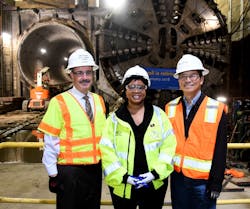L.A. Metro Regional Connector Tunnel Boring Machine “Angeli” Retires
Angeli, the tunnel boring machine (TBM) mining the underground tunnels for the Los Angeles County Metropolitan Transportation Authority’s Regional Connector Transit Project, achieved a key construction milestone this month by completing the second tunnel and will now officially retire from the light rail project.
“Connecting our rail systems makes our communities more inclusive, brings our neighborhoods closer together, and provides our region with a shared sense of belonging,” said Los Angeles Mayor and Metro Board Chair Eric Garcetti. “Angeli has been hard at work over the last year digging tunnels that will bring us an interconnected transit network, and today’s milestone is an example of the progress we’re making.”
Angeli was lowered into the ground near the Little Tokyo/Arts District Station at 1st and Central in late 2016 and began digging the tunnels in early 2017. The first tunnel was completed in July.
Angeli was then taken apart and transported back to the 1st and Central Station site in Little Tokyo where the TBM was reassembled to begin mining the second tunnel. That work was finished in January.
"There is nothing ‘boring’ about the advancements Angeli has made on this critical transportation project,” said Metro Board Member and L.A. County Supervisor Hilda L. Solis. “As this project marks this important milestone, Metro and I remain deeply committed to helping the residents and businesses who have been impacted during construction. Metro remains resolute in our efforts to offer supportive marketing assistance programs to local small businesses with our Business Interruption Fund and the Eat, Shop, Play program."
The TBM was named Angeli, which translates into “angel” as in the city of Angels (Los Angeles). A contest was held among students to name the TBM and the winning name was submitted by Windsor McInerny, a 9th grader attending Woodrow Wilson Classical High School in Long Beach.
Naming of the TBM pays tribute to a mining tradition that dates back to the 14th century. Saint Barbara, the patron saint for military engineers and miners, has long been revered by underground workers as a symbol of protection and good luck. This homage evolved into the tradition of giving tunneling machines a name before digging begins.
The $1.75-billion Regional Connector Transit Project is a 1.9-mile underground light-rail tunnel that will connect the Blue, Expo and Gold Lines in downtown Los Angeles and will include three new stations at 1st Street/Central Avenue, 2nd Street/ Broadway and 2nd Place/Hope Street. The rail line is expected to serve 88,000 riders daily — including 17,000 new riders — and save commuters up to 20 minutes by reducing the need to transfer when traveling to and through downtown L.A. Construction is expected to be completed in 2021.
“Transforming the L.A. region through an aggressive transportation initiative has taken a giant step forward today,” said Metro CEO Phillip A. Washington. “When completed, this project will be a real game changer for the entire region by connecting three light rail lines that together have more than 180,000 boardings every weekday. Riders on the Metro Blue, Gold and Expo lines will reap the benefits of this project for generations to come.”
The TBM was manufactured in Germany by Herrenknecht AG. It weighs approximately 1,000 tons, is 400 feet long and is 21.6 feet in diameter. It advanced about 70 feet per day on average and mined 10,900 feet between the two tunnels and excavated over four million cubic feet or 240,000 tons of earth.
“With the completion of the tunnels, construction will turn toward completing the three underground stations and the last portion of rail tunnel under Flower Street,” added Washington.
Metro has contracted with Regional Connector Constructors (RCC), a joint venture between Skanska, and Traylor Brothers Inc., to design and build the Regional Connector Transit Project.
“RCC is pleased with the safety performance and progress made to date,” said Greg Zwiep, deputy project manager for the Regional Connector Constructors. “Everyone involved takes pride in the work they are doing to improve our transportation system and bridge the gap in light rail lines in downtown Los Angeles.”
